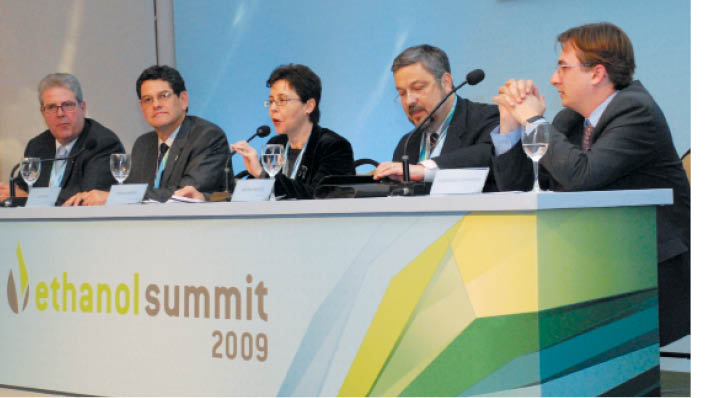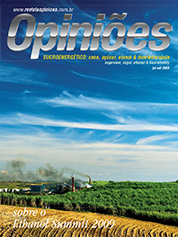Ricardo de Gusmão Dornelles
Director of Renewable Fuel Department of the Ministry of Mines and Energy
Op-AA-21
Energy matrix: how the government can contribute
The Brazilian energy matrix is no doubt an example for the world among the large economies. The matrix stands out mainly due to the share of renewable energy resources, currently in excess of 45%, considering all the country’s primary energy sources. To talk of an energy matrix is to talk of energy safety, and ultimately, of national sovereignty. This is no static theme.
By that I mean that it is not a theme which is data in the immutable reality of our country, but rather, that it is in fact the dynamic construction of conditions to assure the supply of energy, preferably increasingly cleaner, so as to achieve, based thereupon, sustained economic growth. It was based on this version that UNICA, upon formatting the 2009 Ethanol Summit, rightly decided to cover this theme, bringing to the debate representatives of the Executive Branch, the Legislative Branch and of private initiative.
The State does not participate in the production process, but it decisively performs through regulatory actions, within the context of a market economy, articulating a development model that can provide society widespread economic, social and environmental benefits. The panel in which I participated was moderated by Tereza Campello – Deputy Sub-Chief for Articulation and Monitoring of the Federal Government’s Office of the Chief of Staff.
Speakers were Antônio Palocci - Federal Congressman and former Minister of Finance; Alexandre Strapasson - Director of the Agroenergy Department of the Ministry of Agriculture, Livestock Breeding and Supply, and Alísio Vaz, Vice-president of the National Association of Fuel & Lubricant Distribution Companies (SINDICOM), who contributed with the vision of private initiative, in the capacity as an essential agent in the fuel distribution chain.
Currently, products obtained from sugarcane are the country’s second largest energy source, responsible for 16.7% of Brazil’s domestic energy supply (2008). Second only to petroleum and its derivatives (37.6%), but having surpassed hydroelectricity (14%), these products are the country’s main renewable energy source.
 With respect to the increasing share of sugarcane bagasse in the co-generation of electric power in ethanol and sugar producing mills, it is this participation of ethanol in the fuel matrix that is responsible for the distinct position of sugarcane-derived products in the energy matrix.
With respect to the increasing share of sugarcane bagasse in the co-generation of electric power in ethanol and sugar producing mills, it is this participation of ethanol in the fuel matrix that is responsible for the distinct position of sugarcane-derived products in the energy matrix.
Therefore, the first topic covered in the debate was precisely the need to provide the country with a regulatory mark that places ethanol in the context of the legislation on fuel.
As the first speaker, Congressman Antônio Palocci stressed the strategic importance of providing the country the legal instruments capable of placing ethanol in the fuel category, which would extraordinarily facilitate making biofuel a commodity. Actually, this is a topic of essential importance in the Brazilian strategy for promoting biofuel in the international market.
Brazilian ethanol has all the prerequisites to compete against its fossil competitor, gasoline, and to set up a trading model compatible with the supply scale in the fuel market. The Brazilian energy policy, established by Law 9.478/97, is clear in its principles, which are: assure the long-term energy supply, seek to make energy prices affordable, promote the maintenance of local industry’s competitiveness, and take into consideration climate changes and the environment.
In this context, biofuel’s participation is essential. The referenced law also makes this evident when it textually orients the energy policy towards incrementing biofuels’ participation in the national energy matrix, to:
1. promote energy safety with less external dependency;
2. protect the environment;
3. protect consumer interests through regulation and monitoring by the regulatory body, and
4. promote free competition.
What are the instruments capable of promoting this energy policy? Or to use the question placed before the panel in this debate, how can the public authority contribute? The partial answer is through indicative planning, which can guide government and private initiative actions. Another important dimension, which addresses government governance, is to provide a stable regulatory mark, compatible with the market of which it is a part.
Other options include creating specific mandatory markets (more important nowadays in Brazil, as in the case of biodiesel), fiscal policy, capable of correcting distortions in the market, and, finally, credit lines and economic incentives. Lastly, but not less important, are the issues involving research, technological development and innovation for the sustainable production of biofuel.
The latter, which was actually the determinant vector in Brazil reaching the leading position we nowadays occupy in the industry, is no doubt strategic and would be expected to be present in any implemented model, to promote and bring about increased importance of biofuel in the national energy matrix. Thus, in order for Brazil to stay its course in the successful production and utilization of biofuels, there is still a large challenge ahead.
We intend to increase the use of ethanol in the energy matrix. According to the Decennial Energy Expansion Plan (PDE), published by the Ministry of Mines and Energy, one expects an increase of total demand for ethanol of about 11.3% per year, by 2017. If this expectation is confirmed, Brazilian ethanol production will leap from 27 billion liters per year, in 2008, to 64 billion liters in 2017. Thus, ethanol may represent 80% of liquid fuel used in light vehicles in Brazil in the next decade.
Another tool for planning government actions provides a precise notion of the challenge Brazil faces. The National Energy Plan for 2030 indicates an increase in domestic energy supply from 218 million TPE (in 2005) to more than 557 million TPE in 2030. According to said same document, the country is expected to have a renewable portion of 46.5% in 2030. The share of sugarcane-derived products increases from 13.8% (in 2005) to 18.5% in 2030.
This means Brazil is expected to more than triple the production of energy obtained from biomass, to achieve the participation projected in the industry’s planning, growing from a share of 30 million TPE (in 2005) to more than 103 million TPE in 2030. These figures show that sugarcane will play an even greater role as a source of energy in Brazil. Its potential is known by all of us who continuously defend its expansion on a sustainable basis, for the simple fact that its energy content per cultivated hectare is so expressive.
In the past harvest, more than 570 million tons of sugarcane were harvested. In theory, this represents almost 700 million barrels of petroleum equivalent, considering that the potential energy content of sugarcane is 1.2 barrels of petroleum equivalent per ton. In order to draw a comparison, in 2008 Brazil produced 687 million barrels of petroleum.
It is quite obvious that sugarcane has and will have an increasingly important role in the energy sector. Therefore, it will be necessary that the private sector and the government treat sugarcane as a source of energy capable of providing the country a regulatory mark in tune with this reality. One cannot think of the reality of sugarcane-derived products limited to the horizon of a single harvest, but rather must do so in the medium and long term, given that society demands energy safety capable of providing the country the conditions required for sustained growth.
On the part of the public authority, the doors to constructive dialogue will always be open. It became apparent in this panel at the Ethanol Summit that everyone agrees that the regulatory mark of the industry needs improvement. More than ever, this is the time and this is the opportunity for Brazil to occupy its proper place in the international arena.




